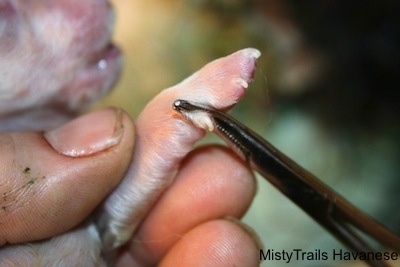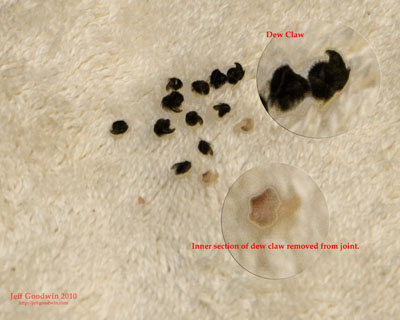Dewclaws
As with many of the topics discussed on our health page, the removal of dewclaws is an automatic that many families and breeders do just because they are “supposed to”. As with everything else, we took a second look and wanted to know why, where the practice came from, and if it truly was best for dogs.
what are dewclaws??
So let’s start out by making sure everyone understands exactly what dewclaws are. Most families never give it thought because they are already gone with the removal site healed up before they ever meet their puppy. We all see in many puppy ads and breeder sites that they are removed….but what actually are they? The dewclaw is an “extra” (we’ll get to why I put that in quotes later!) toe that is part way up the leg and on the inside. Dogs have four “toes” on their paw, and then their dewclaw. It is on the front two legs in basically every dog, and on the back legs in some, but not all breeds. Like I mentioned, it is a bit farther up the leg, and does not come into contact with the ground while the dog is standing or walking.
what does removal entail?
Dewclaw removal is done by breeders or their vets (often along with tails) when puppies are three to five days old. It has come to our attention as we talk with families that many people think that dewclaw removal is simply cutting of a claw that may or may not be present. Many don’t realize that the removal actually takes the entire toe that is present on almost every dog. It is cut off without anesthesia, and is severed off at the joint between the pad of the toe and the leg in a fashion to make the leg smooth.
why are dewclaws commonly removed?
There are several reasons that breeders usually remove dewclaws.
First, there is a cosmetic factor, especially in short-haired breeds. We (as in dog owners in the U.S.) have grown used to seeing the leg without the dewclaw, and the “extra” toe there looks off to us now.
However, the biggest reason that most people will tell you for removing dew claws is that they can catch on things and tear, and the tear may be bad enough that it will have to be removed later in life. While it is true that a dew claw CAN get caught, and it CAN be bad enough to need removal….there are several things wrong with this thinking. First of all, is the obvious point that ANY toe can get caught…..so do we remove all of them at three to five days old? To be the devil’s advocate for a moment, a leg could get caught….or even an ear….and occasionally a dog’s nose gets in the way, too ;) How far should we go with “preventative” removal of parts?
When we first started into Cockapoo’s, we thought we would remove dewclaws, because, that’s what you do….right? But as soon as I saw that the main reason for it was the possibility of the dew claw getting caught on something later in life, I began to rethink things. You see, our other breed (Great Pyrenees) has the normal front leg dew claws AND not just one, but TWO dewclaws on each back leg! In the Great Pyrenees, the SIX dew claws they possess are seen as a wonderful thing, and a dog is faulted in AKC shows if they are not present!
GREAT PYRENEES DEW MATH
2 front dew claws + 4 rear dew claws = Perfect! AKC says leave in tact! This is just how they are supposed to be :)
COCKAPOO DEW MATH
2 front dew claws = DANGER—-YOUR BREEDER IS IRRESPONSIBLE IF THESE AREN’T REMOVED!!!!!
HUH?!?! I don’t get it!
So…..why is there such a fear of Cockapoo dewclaws having an issue, and in sending home 72 Great Pyrenees puppies at the time of my typing, we have never had one issue reported? And keep in mind that dew claws on the rear leg are the most prone to injury. Cockapoos rarely have rear dew claws (we have never seen one) and Pyrenees have four rear dew claws. This really wasn’t adding up to me! This is when I began to look deeper into dewclaws and what they do.
what is the purpose of the dewclaw?
Dewclaws truly are the dog’s “thumb”. If you look at the paw as a hand, it all begins to make sense!
Photo from www.mnn.com
Dewclaws on the front legs are attached with 5 tendons that lead back to 2 major muscle bundles, according to Dr. Christine Zink, DVM, PhD, DACVP, DACVSMR, CCRT, CVSMT, CVA in her 2013 article Do the Dew(claws)? All it takes for a person to realize the dewclaws are ABSOLUTELY used by a dog is for them to watch a dog with intact dewclaws play for a while. They use their dew claws to hold bones or toys, to move things around, to rub their eyes, and in some breeds like the Catahoula Leopard Dog, they use their dew claws to climb trees! Dew claws are also VERY important and can be lifesaving on slick surfaces or if a dog ever falls through ice. While we cannot as readily see it, there are other uses for the dew claw as well—-from walking on rough terrain to quick directional changes while running, the front dew claw serves many purposes in a dog!
are there any health implications to removing dew claws?
Like any medical procedure, you run into certain risks. The biggest immediate risk in newborn puppies with their dew claw removal is that there is a risk for them to pick up an illness from their vet visit for removal, and also the obvious risk of infection at the removal site. In addition, there is always a risk, especially with first time moms, that she may reject puppies after they have been taken from her for the procedure. This is rare, but it does happen.
Although these are concerns——especially infection——the reason we do not remove dewclaws has more to do with new research for the long-term. To return to the research of canine athlete rehabilitation expert, Dr. Christine Zink, the most decisive factor for leaving our puppies dew claws has to do with those tendons and muscle bundles the dew claws on the front legs are attached to. She found that in dogs with their dewclaws removed, those muscles began to atrophy from disuse, putting the dogs at risk for injury and arthritis! On top of this, by using technology to slow down videos, she found that dog’s carpal pad (see picture above for paw anatomy) and dewclaw absolutely come into contact with the ground when running, and that the dewclaw was paramount to keeping the leg from torqueing and twisting every time the paw hit the ground while running—-something that really makes a difference in active dogs over time. In fact, she found that every dog she had treated with carpal arthritis with the exception of one had had their dewclaws removed! Not only can the absence of the dewclaw lead to arthritis, but also to joint injuries that cause the dog other problems. (Read Dr. Zinc’s full article here)
In the end, our research led us to leave dew claws intact on all of our puppies. We do not feel good about risking infection to remove a functional and protective part in order to avoid the possibility of catching their nail later in life.
what you should be aware of in caring for your puppy with intact dewclaws
All of that said, there are two things you need to keep in mind when you have a puppy with dewclaws——especially one with long hair!
You need to make sure that when you trim your puppy’s nails, you make sure that you trim the nail on the dewclaw as well. Almost all front dewclaw injuries take place when nail trimming has been neglected. This also prevents your dog’s nail from becoming ingrown.
You need to make your groomer aware that you puppy has his or her dewclaws intact so that they are careful not to injure the toe during grooming.



